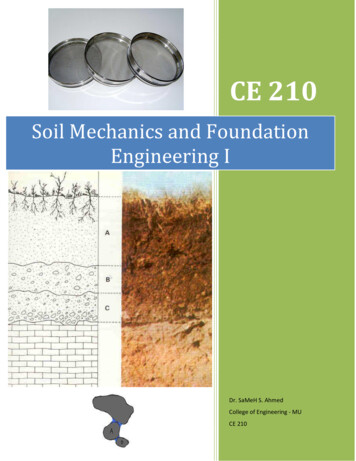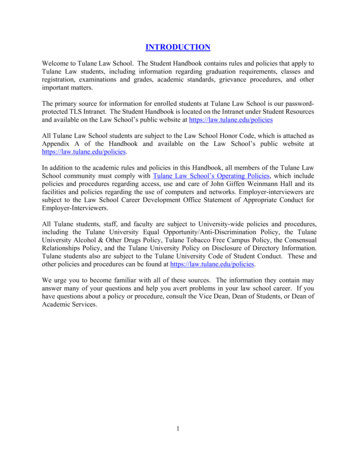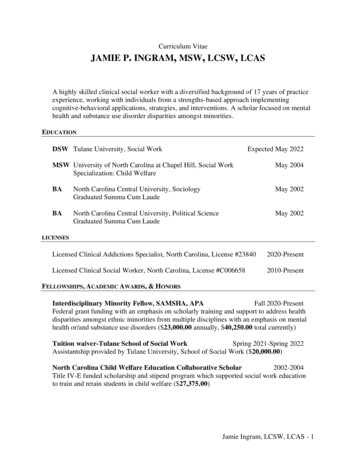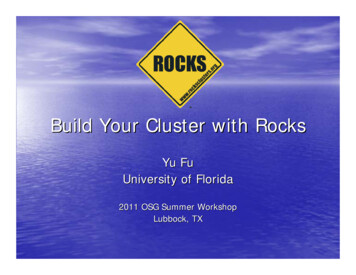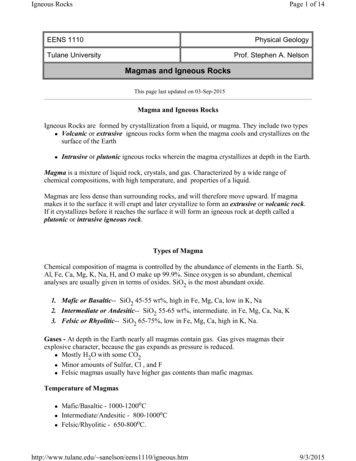
Transcription
Igneous RocksPage 1 of 14EENS 1110Physical GeologyTulane UniversityProf. Stephen A. NelsonMagmas and Igneous RocksThis page last updated on 03-Sep-2015Magma and Igneous RocksIgneous Rocks are formed by crystallization from a liquid, or magma. They include two typesz Volcanic or extrusive igneous rocks form when the magma cools and crystallizes on thesurface of the EarthzIntrusive or plutonic igneous rocks wherein the magma crystallizes at depth in the Earth.Magma is a mixture of liquid rock, crystals, and gas. Characterized by a wide range ofchemical compositions, with high temperature, and properties of a liquid.Magmas are less dense than surrounding rocks, and will therefore move upward. If magmamakes it to the surface it will erupt and later crystallize to form an extrusive or volcanic rock.If it crystallizes before it reaches the surface it will form an igneous rock at depth called aplutonic or intrusive igneous rock.Types of MagmaChemical composition of magma is controlled by the abundance of elements in the Earth. Si,Al, Fe, Ca, Mg, K, Na, H, and O make up 99.9%. Since oxygen is so abundant, chemicalanalyses are usually given in terms of oxides. SiO2 is the most abundant oxide.1. Mafic or Basaltic-- SiO2 45-55 wt%, high in Fe, Mg, Ca, low in K, Na2. Intermediate or Andesitic-- SiO2 55-65 wt%, intermediate. in Fe, Mg, Ca, Na, K3. Felsic or Rhyolitic-- SiO2 65-75%, low in Fe, Mg, Ca, high in K, Na.Gases - At depth in the Earth nearly all magmas contain gas. Gas gives magmas theirexplosive character, because the gas expands as pressure is reduced.z Mostly H O with some CO22z Minor amounts of Sulfur, Cl , and Fz Felsic magmas usually have higher gas contents than mafic magmas.Temperature of MagmaszzzMafic/Basaltic - 1000-1200oCIntermediate/Andesitic - 800-1000oCFelsic/Rhyolitic - 650-800oC.http://www.tulane.edu/ sanelson/eens1110/igneous.htm9/3/2015
Igneous RocksPage 2 of 14Viscosity of MagmasViscosity is the resistance to flow (opposite of fluidity). Depends on composition,temperature, & gas content.zzHigher SiO2 content magmas have higher viscosity than lower SiO2 content magmasLower Temperature magmas have higher viscosity than higher temperature magmas.Summary TableMagmaTypeMafic riteFelsic ratureViscosityGasContent45-55 SiO2 %,Lowhigh in Fe, Mg, 1000 - 1200 oC LowCa, low in K, Na55-65 SiO2 %,intermediate in 800 - 1000 oC Intermediate IntermediateFe, Mg, Ca, Na,K65-75 SiO2 %,low in Fe, Mg, 650 - 800 oCHighHighCa, high in K,NaOrigin of MagmaAs we have seen the only part of the earth that is liquid is the outer core. But the core is notlikely to be the source of magmas because it does not have the right chemical composition.The outer core is mostly Iron, but magmas are silicate liquids. Thus magmas DO NOT COMEFROM THE MOLTEN OUTER CORE OF THE EARTH. Thus, since the rest of the earthis solid, in order for magmas to form, some part of the earth must get hot enough to melt therocks present. We know that temperature increases with depth in the earth along thegeothermal gradient. The earth is hot inside due to heat left over from the original accretionprocess, due to heat released by sinking of materials to form the core, and due to heat releasedby the decay of radioactive elements in the earth. Under normal conditions, the geothermalgradient is not high enough to melt rocks, and thus with the exception of the outer core, most ofthe Earth is solid. Thus, magmas form only under special circumstances. To understand thiswe must first look at how rocks and mineral melt.As pressure increases in the Earth, the melting temperature changes as well. For pure minerals,there are two general cases.http://www.tulane.edu/ sanelson/eens1110/igneous.htm9/3/2015
Igneous RockszzPage 3 of 14For a pure dry (no H2O or CO2present) mineral, the meltingtemperate increases with increasingpressure.For a mineral with H2O or CO2present, the melting temperaturefirst decreases with increasingpressureSince rocks mixtures of minerals, they behave somewhat differently. Unlike minerals, rocks donot melt at a single temperature, but instead melt over a range of temperatures. Thus, it ispossible to have partial melts from which the liquid portion might be extracted to form magma.The two general cases are:zMelting of dry rocks is similar tomelting of dry minerals, meltingtemperatures increase withincreasing pressure, except there is arange of temperature over whichthere exists a partial melt. Thedegree of partial melting can rangefrom 0 to 100%http://www.tulane.edu/ sanelson/eens1110/igneous.htm9/3/2015
Igneous RockszPage 4 of 14Melting of rocks containing water orcarbon dioxide is similar to meltingof wet minerals, melting temperaturesinitially decrease with increasingpressure, except there is a range oftemperature over which there exists apartial melt.Three ways to Generate MagmasFrom the above we can conclude that in order to generate a magma in the solid part of the eartheither the geothermal gradient must be raised in some way or the melting temperature of therocks must be lowered in some way.The geothermal gradient can be raised by upwelling of hot material from below either by uprisesolid material (decompression melting) or by intrusion of magma (heat transfer). Lowering themelting temperature can be achieved by adding water or Carbon Dioxide (flux melting).Decompression Melting Under normal conditionsthe temperature in theEarth, shown by thegeothermal gradient, islower than the beginning ofmelting of the mantle.Thus in order for themantle to melt there has tobe a mechanism to raise thegeothermal gradient. Oncesuch mechanism isconvection, wherein hotmantle material rises tolower pressure or depth,carrying its heat with it.If the raised geothermal gradient becomes higher than the initial melting temperature at anypressure, then a partial melt will form. Liquid from this partial melt can be separated from theremaining crystals because, in general, liquids have a lower density than solids. Basalticmagmas appear to originate in this way.Upwelling mantle appears to occur beneath oceanic ridges, at hot spots, and beneathcontinental rift valleys. Thus, generation of magma in these three environments is likelycaused by decompression melting.http://www.tulane.edu/ sanelson/eens1110/igneous.htm9/3/2015
Igneous RocksPage 5 of 14Transfer of Heat- When magmas that were generated by some other mechanism intrude intocold crust, they bring with them heat. Upon solidification they lose this heat and transfer it tothe surrounding crust. Repeated intrusions can transfer enough heat to increase the localgeothermal gradient and cause melting of the surrounding rock to generate new magmas.Transfer of heat by this mechanism may be responsible for generating some magmas incontinental rift valleys, hot spots, and subduction related environments.Flux Melting - As we saw above, if water or carbon dioxide are added to rock, the meltingtemperature is lowered. If the addition of water or carbon dioxide takes place deep in the earthwhere the temperature is already high, the lowering of melting temperature could cause therock to partially melt to generate magma. One place where water could be introduced is atsubduction zones. Here, water present in the pore spaces of the subducting sea floor or waterpresent in minerals like hornblende, biotite, or clay minerals would be released by the risingtemperature and then move in to the overlying mantle. Introduction of this water in the mantlewould then lower the melting temperature of the mantle to generate partial melts, which couldthen separate from the solid mantle and rise toward the surface.Chemical Variability of MagmasThe chemical composition of magma can vary depending on the rock that initially melts (thesource rock), and process that occur during partial melting and transport.http://www.tulane.edu/ sanelson/eens1110/igneous.htm9/3/2015
Igneous RocksPage 6 of 14Initial Composition of MagmaThe initial composition of the magma is dictated by the composition of the source rock and thedegree of partial melting. In general, melting of a mantle source (garnet peridotite) results inmafic/basaltic magmas. Melting of crustal sources yields more siliceous magmas.In general more siliceous magmas form by low degrees of partial melting. As the degree ofpartial melting increases, less siliceous compositions can be generated. So, melting a maficsource thus yields a felsic or intermediate magma. Melting of ultramafic (peridotite source)yields a basaltic magma.Magmatic DifferentiationBut, processes that operate during transportation toward the surface or during storage in thecrust can alter the chemical composition of the magma. These processes are referred to asmagmatic differentiation and include assimilation, mixing, and fractional crystallization.Assimilation - As magma passes through cooler rock on its way to the surface itmay partially melt the surrounding rock and incorporate this melt into themagma. Because small amounts of partial melting result in siliceous liquidcompositions, addition of this melt to the magma will make it more siliceous.Mixing - If two magmas with different compositions happen to come in contactwith one another, they could mix together. The mixed magma will have acomposition somewhere between that of the original two magma compositions.Evidence for mixing is often preserved in the resulting rocks.Fractional Crystallization - When magma crystallizes it does so over a range oftemperature. Each mineral begins to crystallize at a different temperature, and ifthese minerals are somehow removed from the liquid, the liquid composition willchange. The processes is called magmatic differentiation by FractionalCrystallization.Because mafic minerals like olivine and pyroxene crystallize first, the processresults in removing Mg, Fe, and Ca, and enriching the liquid in silica. Thus crystalfractionation can change a mafic magma into a felsic magma.Crystals can be removed by a variety of processes. If the crystals are more densethan the liquid, they may sink. If they are less dense than the liquid they will float.If liquid is squeezed out by pressure, then crystals will be left behind. Removal ofcrystals can thus change the composition of the liquid portion of the magma. Letme illustrate this using a very simple case.Imagine a liquid containing 5 molecules of MgO and 5 molecules of SiO2. Initiallythe composition of this magma is expressed as 50% SiO2 and 50% MgO. i.e.http://www.tulane.edu/ sanelson/eens1110/igneous.htm9/3/2015
Igneous RocksPage 7 of 14Now let's imagine I remove 1 MgO molecule by putting it into a crystal andremoving the crystal from the magma. Now what are the percentages of eachmolecule in the liquid?If we continue the process one more time by removing one more MgO moleculeThus, composition of liquid can be changed.Bowen's Reaction SeriesBowen found by experiment that the order in which minerals crystallize from a basaltic magmadepends on temperature. As a basaltic magma is cooled Olivine and Ca-rich plagioclasecrystallize first. Upon further cooling, Olivine reacts with the liquid to produce pyroxene andCa-rich plagioclase react with the liquid to produce less Ca-rich plagioclase. But, if the olivineand Ca-rich plagioclase are removed from the liquid by crystal fractionation, then theremaining liquid will be more SiO2 rich. If the process continues, an original basaltic magmacan change to first an andesite magma then a rhyolite magma with falling temperaturehttp://www.tulane.edu/ sanelson/eens1110/igneous.htm9/3/2015
Igneous RocksPage 8 of 14Igneous Environments and Igneous RocksThe environment in which magma completely solidifies to form a rock determines:1. The type of rock2. The appearance of the rock as seen in its texture3. The type of rock body.In general there are two environments to consider:The intrusive or plutonic environment is below the surface of the earth. This environment ischaracterized by higher temperatures which result in slow cooling of the magma. Intrusive orplutonic igneous rocks form here.Where magma erupts on the surface of the earth, temperatures are lower and cooling of themagma takes place much more rapidly. This is the extrusive or volcanic environment andresults in extrusive or volcanic igneous rocks.Extrusive EnvironmentsWhen magmas reach the surface of the Earth they erupt from a vent called a volcano. Theymay erupt explosively or non-explosively.zNon-explosive eruptions are favored by low gas content and low viscosity magmas(basaltic to andesitic magmas and sometimes rhyolitic magma).{Usually begin with fire fountains due to release of dissolved gaseshttp://www.tulane.edu/ sanelson/eens1110/igneous.htm9/3/2015
Igneous RockszPage 9 of 14{Produce lava flows on surface{Produce Pillow lavas if erupted beneath waterExplosive eruptions are favored by high gas content and high viscosity (andesitic torhyolitic magmas).{{{Expansion of gas bubbles is resisted by high viscosity of magma - results inbuilding of pressureHigh pressure in gas bubbles causes the bubbles to burst when reaching the lowpressure at the Earth's surface.Bursting of bubbles fragments the magma into pyroclasts and tephra (ash).Cloud of gas and tephra rises above volcano to produce an eruption column thatcan rise up to 45 km into the atmosphere.Tephra that falls from the eruption columnproduces a tephra fall deposit.{If eruption column collapses a pyroclastic flowmay occur, wherein gas and tephra rush down theflanks of the volcano at high speed. This is themost dangerous type of volcanic eruption. Thedeposits that are produced are called ignimbrites.Intrusive EnvironmentsMagma that cools at depth form bodies of rocks called intrusive bodies or plutonic bodiescalled plutons, from Greek god of the underworld - Pluto. When magma intrudes it usuallyaffects the surrounding rock and is also affected by the surrounding rock. It maymetamorphose the surrounding rocks or cause hydrothermal alteration. The magma itself mayalso cool rapidly near the contact with the surrounding rock and thus show a chilled marginnext to the contact.http://www.tulane.edu/ sanelson/eens1110/igneous.htm9/3/2015
Igneous RocksPage 10 of 14It may also incorporate pieces of the surroundingrocks without melting them. These incorporatedpieces are called xenoliths (foreign rocks).Magma intrudes by injection into fractures in the rockand expanding the fractures. The may also move bya process called stoping, wherein bocks are loosenedby magma at the top of the magma body with theseblocks then sinking through the magma to accumulateon the floor of the magma body.In relatively shallow environments intrusions are usually tabular bodies like dikes and sills ordomed roof bodies called laccoliths.zzDikes are small ( 20 m wide)shallow intrusions that show adiscordant relationship to the rocksin which they intrude. Discordantmeans that they cut acrosspreexisting structures. They mayoccur as isolated bodies or mayoccur as swarms of dikesemanating from a large intrusivebody at depth.Sills are also small ( 50 m thick)shallow intrusions that show aconcordant relationship with therocks that they intrude. Sillsusually are fed by dikes, but thesemay not be exposed in the field.http://www.tulane.edu/ sanelson/eens1110/igneous.htm9/3/2015
Igneous RockszPage 11 of 14Laccoliths are somewhat largeintrusions that result in uplift andfolding of the preexisting rocksabove the intrusion. They are alsoconcordant types of intrusions.Deeper in the earth intrusion of magma can form bulbous bodies called plutons and thecoalescence of many plutons can form much larger bodies called batholiths.zzzPlutons are large intrusive bodies, of any shape that intrude in replace rocks in anirregular fashion.Stocks are smaller bodies that are likely fed from deeper level batholiths. Stocks mayhave been feeders for volcanic eruptions, but because large amounts of erosion arerequired to expose a stock or batholith, the associated volcanic rocks are rarely exposed.If multiple intrusive events occurin the same part of the crust, thebody that forms is called abatholith. Several largebatholiths occur in the westernU.S. - The Sierra NevadaBatholith, the Coast RangeBatholith, and the IdahoBatholith, for example (Seefigure 6.10d in your text).During a magmatic event there is usually a close relationship between intrusive activity andextrusive activity, but one cannot directly observe the intrusive activity. Only after erosion ofthe extrusive rocks and other rock above the intrusions has exposed the intrusions do theybecome visible at the earth's surface (see figure 6.10a in your text).The rate of cooling of magma depends largely on the environment in which the magma cools.Rapid cooling takes place on the Earth's surface where there is a large temperature contrastbetween the atmosphere/ground surface and the magma. Cooling time for material erupted intoair and water can be as short as several seconds. For lava flows cooling times are on the orderof days to weeks. Shallow intrusions cool in months to years and large deep intrusions maytake millions of years to cool.http://www.tulane.edu/ sanelson/eens1110/igneous.htm9/3/2015
Igneous RocksPage 12 of 14Because cooling of the magma takes place at a different rate, thecrystals that form and their interrelationship (texture) exhibit differentproperties.zzzFast cooling on the surface results in many small crystals orquenching to a glass. Gives rise to aphanitic texture (crystalscannot be distinguished with the naked eye), or obsidian(volcanic glass).Slow cooling at depth in the earth results in fewer much larger crystals,gives rise to phaneritic texture.Porphyritic texture develops when slow cooling is followedby rapid cooling. Phenocrysts larger crystals, matrix orgroundmass smaller crystals.Classification of Igneous RocksIgneous rocks are classified on the basis of texture and chemical composition, usually asreflected in the minerals that from due to crystallization. You will explore the classification ofigneous rocks in the laboratory portion of this course.Extrusive/Volcanic RocksBasalts, Andesites, and Rhyolites are all types of volcanic rock distinguished on the basis oftheir mineral assemblage and chemical compostion (see figure 6.13 in your text). These rockstend to be fine grained to glassy or porphyritic. Depending on conditions present duringeruption and cooling, any of these rock types may form one of the following types of volcanicrocks.z Obsidian - dark colored volcanic glass showing concoidal fracture and few to nocrystals. Usually rhyolitic .zzzzPumice - light colored and light weight rock consisting of mostly holes (vesicles) thatwere once occupied by gas, Usually rhyolitic or andesitic.Vesicular rock - rock filled with holes (like Swiss cheese) or vesicles that were onceoccupied by gas. Usually basaltic and andesitic.If vesicles in a vesicular basalt are later filled by precipitation of calcite or quartz, thefillings are termed amygdules and the basalt is termed an amygdularl basalt.Pyroclasts hot, broken fragments. Result from explosively ripping apart of magma.Loose assemblages of pyroclasts called tephra. Depending on size, tephra can beclassified as bombs. lapilli, or ash.http://www.tulane.edu/ sanelson/eens1110/igneous.htm9/3/2015
Igneous RockszPage 13 of 14Rock formed by accumulation and cementation of tephra called a pyroclastic rock ortuff. Welding, compactioncause tephra (loose material) to be converted in pyroclasticrock.Intrusive/Plutonic Igneous RocksShallow intrusions like dikes and sills are usually fine grained and sometimes porphriticbecause cooling rates are similar to those of extrusive rocks. Classification is similar to theclassification for volcanic/extrusive rocks. Coarse grained rocks, formed at deeper levels in theearth include gabbros, diorites, and granites. Note that these are chemically equivalent tobasalts, andesites, and rhyolites, but may have different minerals or different proportions ofmineral because their crystallization history is not interrupted as it might be for extrusive rocks(see figure 6.13 in your text).Pegmatites are very coarse grained igneous rocks consisting mostly of quartz and feldspar aswell as some more exotic minerals like tourmaline, lepidolite, muscovite. These usually formdikes related to granitic plutons.Distribution of Igneous ActivityIgneous activity is currently taking place as it has in the past in various tectonic settings.These include diverging and converging plate boundaries, hot spots, and rift valleys.Divergent Plate BoundariesAt oceanic ridges, igneous activity involves eruption of basaltic lava flows that form pillowlavas at the oceanic ridges and intrusion of dikes and plutons beneath the ridges. The lavaflows and dikes are basaltic and the plutons mainly gabbros. These processes form the bulk ofthe oceanic crust as a result of sea floor spreading. Magmas are generated by decompressionmelting as hot solid asthenosphere rises and partially melts.Convergent Plate BoundariesSubduction at convergent plate boundaries introduces water into the mantle above thesubduction and causes flux melting of the mantle to produce basaltic magmas. These risetoward the surface differentiating by assimilation and crystal fractionation to produce andesiticand rhyolitic magmas. The magmas that reach the surface build island arcs and continentalmargin volcanic arcs built of basalt, andesite, and rhyolite lava flows and pyroclastic material.The magmas that intrude beneath these arcs can cause crustal melting and form plutons andbatholiths of diorite and graniteHot SpotsAs discussed previously, hot spots are places are places where hot mantle ascends toward thesurface as plumes of hot rock. Decompression melting in these rising plumes results in theproduction of magmas which erupt to form a volcano on the surface or sea floor, eventuallybuilding a volcanic island. As the overriding plate moves over the hot spot, the volcano movesoff of the hot spot and a new volcano forms over the hot spot. This produces a hot spot trackconsisting of lines of extinct volcanoes leading to the active volcano at the hot spot. A hot spothttp://www.tulane.edu/ sanelson/eens1110/igneous.htm9/3/2015
Igneous RocksPage 14 of 14located beneath a continent can result in heat transfer melting of the continental crust toproduce large rhyolitic volcanic centers and plutonic granitic plutons below. A good exampleof a continental hot spot is at Yellowstone in the western U.S. Occasionally a hot spot iscoincident with an oceanic ridge. In such a case, the hot spot produces larger volumes ofmagma than normally occur at ridge and thus build a volcanic island on the ridge. Such is thecase for Iceland which sits atop the Mid-Atlantic Ridge.Rift ValleysRising mantle beneath a continent can result in extensional fractures in the continental crust toform a rift valley. As the mantle rises it undergoes partial melting by decompression, resultingin the production of basaltic magmas which may erupt as flood basalts on the surface. Meltsthat get trapped in the crust can release heat resulting in melting of the crust to form rhyoliticmagmas that can also erupt at the surface in the rift valley. An excellent example of acontinental rift valley is the East African Rift.Large Igneous ProvincesIn the past, large volumes of mostly basaltic magma have erupted on the sea floor to form largevolcanic plateaus, such as the Ontong Java Plateau in the eastern Pacific. Such large volumeeruptions can have affects on the oceans because they change the shape of ocean floor andcause a rise in sea level, that sometimes floods the continents. The plateaus form obstructionswhich can drastically change ocean currents. These changes in the ocean along with massiveamounts of gas released by the magmas can alter climate and have drastic effects on life on theplanet.Examples of questions on this material that could be asked on an exam.1. What are the three main types of magma and how are they distinguished in terms of theirchemical composition, temperature, and viscosity?2. What is the main difference between the way that pure minerals melt and the way therocks melt? What effect does the addition of volatiles like H20 and CO2 have?3. What are the main gases that occur in magma?4. What are three ways that magma can be generated? Explain each.5. Define the following: (a) dike, (b) sill, (c) xenolith, (d) stoping, (e) batholith, (f)obsidian, (g) pumice, (h) pyroclast, (i) pegmatite. (Use drawings if it helps).6. What does the texture of an igneous rocks tell us about cooling history?7. Describe the following igneous textures (a) aphanitic, (b) phaneritic, (c) porphyritic.8. Describe the distribution of igneous activity on Earth.Return to EENS 1110 Pagehttp://www.tulane.edu/ sanelson/eens1110/igneous.htm9/3/2015
Tulane University Prof. Stephen A. Nelson Magmas and Igneous Rocks Magma and Igneous Rocks Igneous Rocks are formed by crystallization from a liquid, or magma. They include two types zVolcanic or extrusive igneous rocks form when the magma cools and crystallizes on the surface of the Earth

